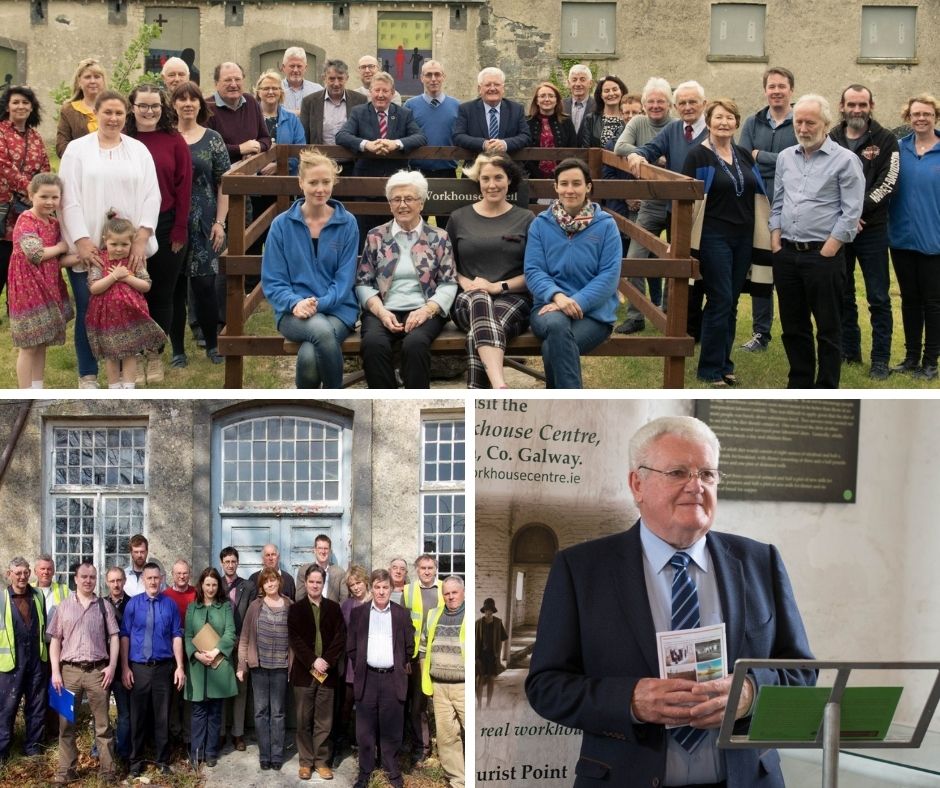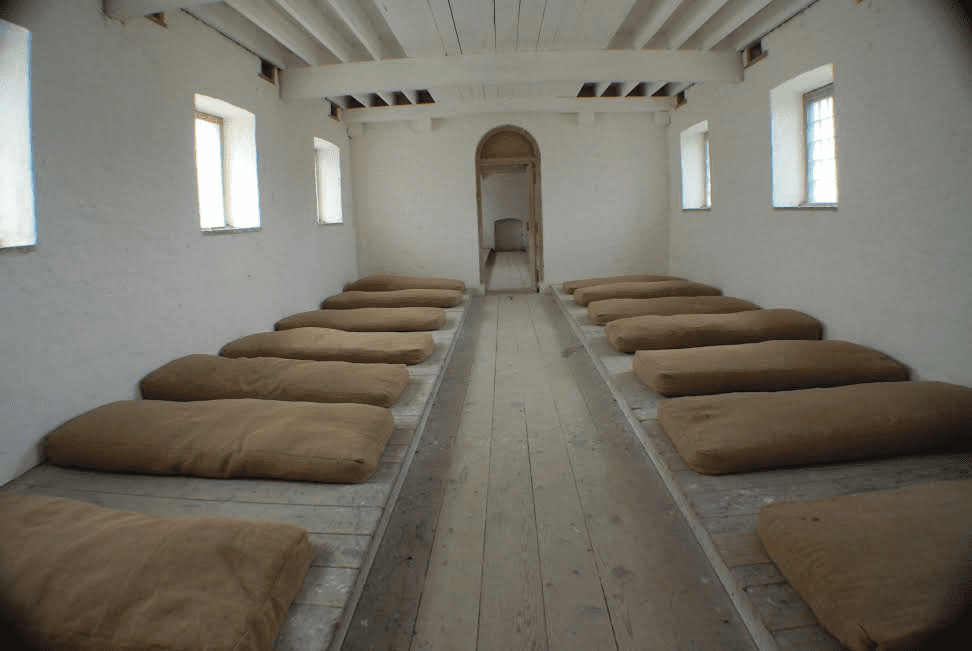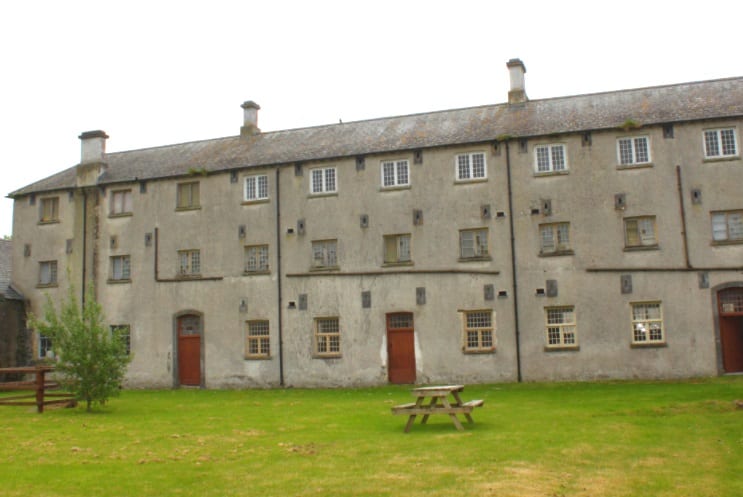About Us
Our Story
The Act for the effectual Relief of the Destitute Poor in Ireland was passed in July 1838. The Poor Law Act placed the workhouse building as a central component in every Union in Ireland. Its purpose was to provide for those who could not provide for themselves. These people were the most vulnerable in society, the old, sick, orphans, and those who had no job, money, or food. Each workhouse was managed by a Board of Guardians, consisting of elected and ex-officio members.
The first workhouse to open in Ireland was built in Cork and began to admit paupers on 1 March 1840 and could accommodate 2,000. Portumna Workhouse opened in 1852, though Portumna Poor Law Union, the area within which the Workhouse operated, was declared on 22 February 1850. The building was constructed to accommodate 600 people and like other workhouses was designed by architect George Wilkinson. It cost £7,875 to build and occupies just over 8 acres of land outside the town.
In all, there were 163 workhouses operating in Ireland until the 1920s built in two phases. The first 130 opened prior to 1850 and the latter 33 were provided in the aftermath of An Gorta Mór.
After this time, the buildings in Portumna were used for many other purposes; an agricultural show was held here, a weaver worked in one of the buildings, and a potato store also operated here for a time.
You can get a feel for our tour and some of the buildings in our introductory film.
Our goals and objectives
In 1999 South East Galway Integrated Rural Development, a not-for-profit local development company initiated a plan to conserve the building and the Irish Workhouse Centre opened to visitors in 2011. Today, staff provide tours of the building and share the story of the workhouse poor.
Our goals and objectives are to provide a resource centre and programmes aimed at encouraging and profiting efforts, ideas and enterprises and creativity, operate workshops and training schemes for the development of art, music, creative writing, culture, and associated subjects, encourage training in community development, leadership, organisational skills and social analysis for the benefit of the entire community promote dialogue and collaboration between local groups and statutory agencies. We look forward to sharing the story of the workhouse with you.

Friends of the Workhouse
We are also greatly indebted to the ‘Friends of the Workhouse’, who over the years have supported our work, and continue to do so by donating funds towards various workhouse projects. Many of these donors have contributed towards the plaques in the workhouse windows remembering family members.
In acknowledging this support we remember all the Friends and their families.
Conservation and Re-use

The women’s dormitory-like most parts of the workhouse where paupers lived and worked were whitewashed with limewash as a means to prevent disease. The ceilings and walls did not have any insulation and so the rooms were very cold and draughty. The raised platforms you see was where the pauper mattresses were laid out. Each night after dinner, you returned to your dormitory which was locked until the following morning. Chamber pots were used as toilets. There was little comfort offered to the poor of the workhouse.
The workhouses in Ireland were designed by George Wilkinson. He was born in Oxfordshire, into a family of builder-architects. Although it seems that he had received no formal architectural training, he showed great skill and discipline. By his twenty-first birthday, he had built eight workhouses in England. He arrived in Ireland, aged 24, in 1839/40. He was appointed to design and supervise the construction of all the workhouses. By 1840, 84 workhouses were under construction. By 1843, 112 were finished. By 1847, 130 were built. A further 33 were constructed after 1850. The workhouse was built by private contract and each workhouse would have taken about two years to build. The construction of the workhouses, in such a short time frame, was a huge undertaking.
Wilkinson treated the workhouse as a building type. The first 130 were built to a generic design largely from locally sourced materials. In the later phase (33 workhouses), during which Portumna Workhouse was built, Wilkinson changed the design somewhat. Also, in response to criticism of damp penetration in the first phase of workhouses, the facades were rendered with lime and timber.
Portumna Workhouse consists of 7 large buildings, grouped around four yards.
Block A – Girls’ Building including waiting hall, school room and probationary ward
Block B – Boys’ Building including master’s quarters
Block C – Women’s Building including matron’s quarters
Block D – Men’s Building
Block E – Chapel & Kitchen/Dining Area
Block F – Laundry Building
Block G – Infirmary
Poor Law Union of Portumna declared
Building Opened
Master Henry Ogle disappears
Death of Fr. Patrick Donnellan in USA
Paupers refuse to eat Australian meat
Mercy Nuns Arrive
Woodford Evictions
Outbreak of Smallpox
Last Board of Guardians meeting
Hot water system suggested for the infirmary
Workhouse turf, pigs & vegetables to be sold to the military
Workhouse closes - infirmary inmates sent to Loughrea
Portumna District Council objects to the sale of workhouse buildings
Room in workhouse let to Mr. Zimmerman as a knitting factory
Portumna Agricultural Show held on Workhouse grounds
Portumna Agricultural Show accepted as tenants at Workhouse for 11 months
People die at home rather than going into Central Hospital, Galway
Workhouse buildings converted to offices for Bord na Mona
Messrs Tipping Gear factory housed in Workhouse since 1954 closes
High wall at the workhouse is removed over safety concerns
General Textiles cotton spinning at Workhouse
Portumna Packers Co-Op Ltd lease Workhouse buildings
South East Galway Integrated Rural Development Company examine ways to re-use the site
The workhouse was opened to the public, as the Irish Workhouse Centre
Some of our window conservation work
There are 280 windows in the entire complex. 26 are sliding sash windows. These are in the staff quarters. All the others are casement windows. The timber used in the construction of the windows was mostly Pitch Pine and Douglas Fir. A small number of windows in the staff quarters have shutters.
Most of the windows in Blocks A & Block C were not beyond repair. Repairs to the frames were carried out on site. This was important given that the frames were placed in the building during the construction of the brickwork instead of placing the frames in the opening of a completed wall. The windows were repaired using pitch pine, to match the original timber used. Much of the original ironmongery on the windows was still present and working. This was cleaned and repaired where necessary. Where ironmongery was missing or beyond repair, it was replaced like for like.
Although historic buildings are not required to meet BER regulations, optimising energy efficiency was an important goal in work on Block A. There are a number of ways that historic windows can be adapted to reduce heat loss and it was decided here to use the least obtrusive, which was also the least expensive. In Block A, all the windows and doors were draught proofed by using special strips and brushes.

